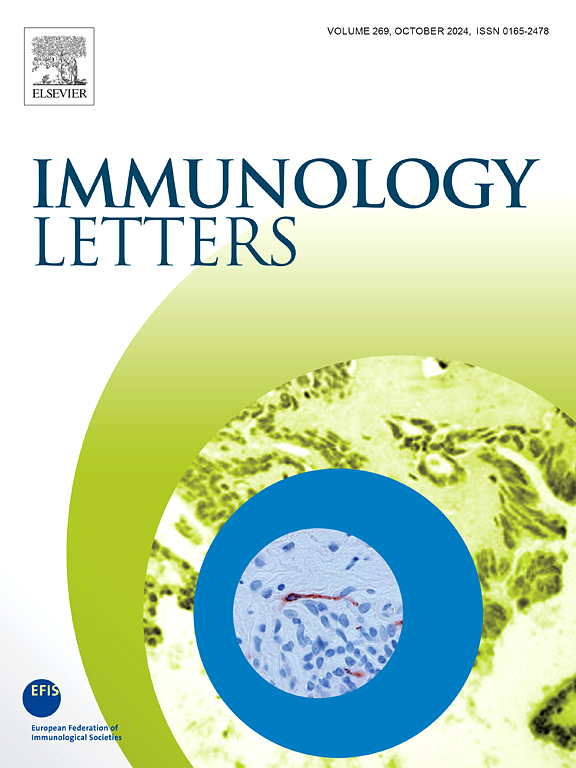Heparanase inhibition mitigates bleomycin-induced pulmonary fibrosis in mice by reducing M2 macrophage polarization
IF 3.3
4区 医学
Q3 IMMUNOLOGY
引用次数: 0
Abstract
Objective
This study investigates the involvement of heparanase in IPF pathogenesis and evaluates the therapeutic potential of heparanase inhibition.
Methods
Plasma heparanase levels were measured in IPF patients and healthy controls. Macrophage infiltration and heparanase expression in bronchoalveolar lavage fluid (BALF) were analyzed using immunofluorescence. Bleomycin (BLM)-induced pulmonary fibrosis mouse models were treated with the heparanase inhibitor OGT2115. Disease severity, macrophage polarization, and heparanase expression were assessed through histological staining, hydroxyproline content measurement, flow cytometry, immunofluorescence, Transmission Electron Microscopy and Western blot analysis.
Results
Elevated heparanase levels were found in the plasma of IPF patients and in macrophages from BALF. In BLM-induced mice, heparanase was predominantly expressed in M2 macrophages. OGT2115 treatment significantly reduced mortality, body weight loss, and fibrosis severity. Additionally, OGT2115 decreased M2 macrophage infiltration, attenuated lung fibrosis, and reduced autophagy markers LC3 I/II and P62.
Conclusion
Heparanase plays a crucial role in modulating M2 macrophage polarization and the progression of IPF. Targeting heparanase with OGT2115 effectively ameliorates pulmonary fibrosis and represents a promising therapeutic strategy for IPF management.
肝素酶抑制通过减少M2巨噬细胞极化减轻博莱霉素诱导的小鼠肺纤维化
目的探讨肝素酶在IPF发病机制中的作用,评价抑制肝素酶治疗IPF的潜力。方法测定IPF患者和健康对照者血浆肝素酶水平。采用免疫荧光法分析支气管肺泡灌洗液(BALF)中巨噬细胞浸润及肝素酶表达。用肝素酶抑制剂OGT2115治疗博来霉素(BLM)诱导的肺纤维化小鼠模型。通过组织染色、羟脯氨酸含量测定、流式细胞术、免疫荧光、透射电镜和Western blot分析,评估疾病严重程度、巨噬细胞极化和肝素酶表达。结果IPF患者血浆及BALF巨噬细胞中肝素酶水平升高。在blm诱导小鼠中,肝素酶主要在M2巨噬细胞中表达。OGT2115治疗可显著降低死亡率、体重减轻和纤维化严重程度。此外,OGT2115减少M2巨噬细胞浸润,减轻肺纤维化,降低自噬标志物LC3 I/II和P62。结论肝素酶在调节M2巨噬细胞极化和IPF进展中起重要作用。OGT2115靶向肝素酶可有效改善肺纤维化,是治疗IPF的一种有前景的治疗策略。
本文章由计算机程序翻译,如有差异,请以英文原文为准。
求助全文
约1分钟内获得全文
求助全文
来源期刊

Immunology letters
医学-免疫学
CiteScore
7.60
自引率
0.00%
发文量
86
审稿时长
44 days
期刊介绍:
Immunology Letters provides a vehicle for the speedy publication of experimental papers, (mini)Reviews and Letters to the Editor addressing all aspects of molecular and cellular immunology. The essential criteria for publication will be clarity, experimental soundness and novelty. Results contradictory to current accepted thinking or ideas divergent from actual dogmas will be considered for publication provided that they are based on solid experimental findings.
Preference will be given to papers of immediate importance to other investigators, either by their experimental data, new ideas or new methodology. Scientific correspondence to the Editor-in-Chief related to the published papers may also be accepted provided that they are short and scientifically relevant to the papers mentioned, in order to provide a continuing forum for discussion.
 求助内容:
求助内容: 应助结果提醒方式:
应助结果提醒方式:


